Reproduction
Spirea Anthony Vaterer is a hybrid plant, therefore it does not propagate by seeds. It can only be rooted with cuttings and shoots.
Cuttings are harvested in mid-June, when the intensive growth of shoots ends. Thick woody branches are cut and divided into smaller ones, 10 cm each. Small twigs are dipped at one end into a solution of water with a growth stimulator for 12 hours. Then they are rooted in a mixture of peat and sand (1: 1 ratio). In order for the cuttings to take root quickly, frequent watering is necessary, at least once every 2 days.
In the spring, grown plants with a formed rhizome are transferred to a flower bed and planted in a permanent place, observing all the rules.

Multiply Spirea Anthony Vaterer shoots can be in the spring. For this, strong young, well-developed layers are chosen. They are neatly bent and fixed approximately in the middle with metal brackets. This must be done so that the shoot is in contact with the soil. Along its entire length, it is covered with fluffed earth.
Watering is carried out regularly, about 2-3 times a month. For the winter, the plant is insulated with peat or fallen leaves. Next spring, the spirea will finally take root, it can be separated from the mother bush and transferred to the right place.
Most spirits, including the hybrid Anthony Vaterer, take root well, and their survival rate is high. Therefore, it is not difficult to propagate the mother plant. The main thing is to follow the rules of watering and protect young seedlings from winter frosts.
How to plant?
Japanese spirea is considered an unpretentious plant in planting and care. To achieve lush flowering and healthy development, it is necessary not only to properly care for it, but also to choose the right place for planting. The best time is spring. The event should be carried out in cloudy weather, and it should be planted in a well-lit place. Only in this case it is possible to achieve maximum decorativeness both in the color of the leaves and in abundant flowering.
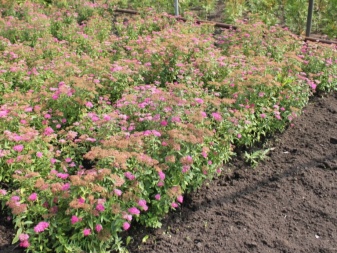
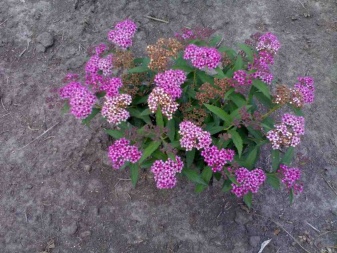
The root system of the spirea is fibrous and grows quite intensively, so the plant receives the necessary nutrients and moisture only from the top layer of the soil. Therefore, for better growth, choose a place that is more spacious. Japanese spirea is relatively undemanding to the composition of the soil, but prefers to grow on slightly alkaline soil (pH: 7–7.5). If the soil is poor and heavy, before planting it is necessary to apply complex mineral fertilizers and organic matter in the form of humus or compost.

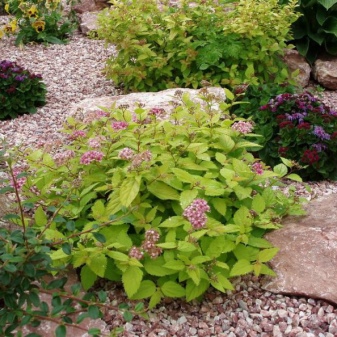
Buy bushes grown in containers, which increases the chances of successful rooting
If you buy seedlings with open roots, pay attention to their condition. They should not be overdried and damaged, shoots with live, but not yet awakened buds
To check for "freshness" use a simple method: shoots and roots should be slightly springy to the touch, while not breaking at the slightest touch.
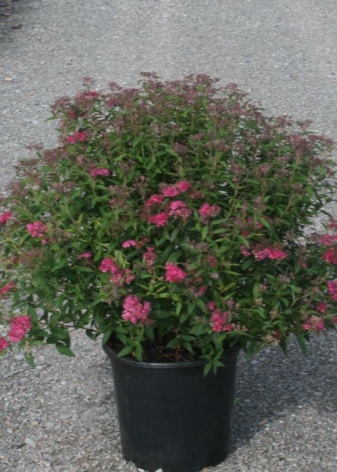

Before planting the Japanese spirea, you first need to prepare the planting pit, a week before planting the plant. It should be one third larger than the volume of the root system of the shrub. A thick layer of drainage is laid at the bottom of the hole, consisting of broken brick and large rubble. The soil substrate for young seedlings should be nutritious and consist of humus, peat, sand and sod soil. The prepared soil mixture is thoroughly mixed. Remove dry, damaged roots, and shorten too long ones. First, you need to disinfect the roots by soaking them for several hours in a weak solution of potassium permanganate.
After carrying out the preparatory work, the bush seedling is placed in the hole, the roots are gently straightened, filled with a prepared soil mixture, carefully compacting it. The root neck of the spirea should be above the ground. After the plant is abundantly watered and mulching is carried out. A simple method prevents weed growth and does not allow moisture to intensively evaporate from the soil. The final stage of planting is feeding the plant with ammonia. It is carried out a few days after disembarkation and during the period of active growth.
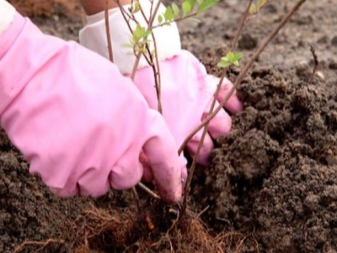
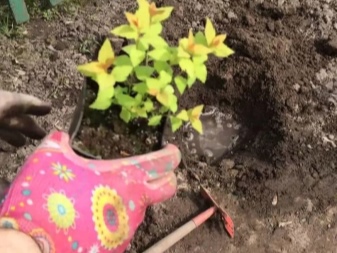
Loosening and pruning

The bush needs constant care, the soil around is loosened with special tools and weeds are removed. For proper plant growth, pruning is also important, it is carried out in accordance with the following requirements:
- Shrub shoots are shortened to developed buds. Too thin branches without signs of buds are cut off completely. Correct haircut allows you to make the crown more luxurious and thicker.
- Shrubs are trimmed at the age of 5 years after the annual flowering. In the process, the entire top is cut off without fail, leaving only 30 centimeters of the plant in the root area;
- A 6-year-old shrub is cut to a stump after flowering.
It is the haircut that allows you to give the shrub the desired shape. Be sure to remove any shoots on which the inflorescences have died. This way you can rejuvenate the plant and stimulate it to form new young shoots.
In some cases, pruning of shoots in early spring is allowed, so the spirea will bloom better. Pruning is also done to shape the shrub when using plants in hedges.
Fertilizing and feeding plants
It is recommended to feed Japanese spirea twice a year:
- in the spring at the end of the pruning of the bushes - with complex fertilizer according to the instructions attached to it;
- in summer during flowering - with organic fertilizer, adding superphosphate, which improves the formation of new inflorescences.
As an organic fertilizer, you can use mullein, which is diluted with water in a quantitative ratio of 1: 6. In the absence of cow dung, it is replaced with chicken droppings, diluted with water 1:18. It is enough to take 10 g of superphosphate per bucket of the resulting solution.
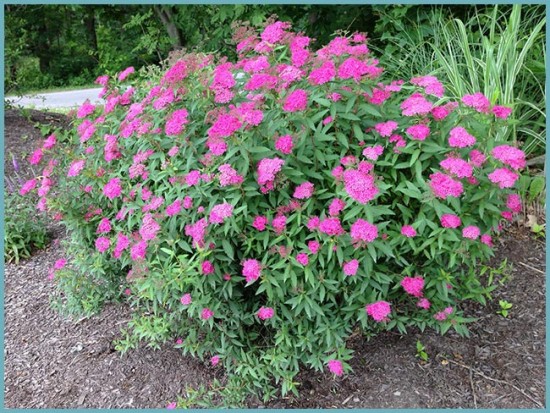 You need to feed the spirea 2 times a year.
You need to feed the spirea 2 times a year.
Plants also get a certain amount of nutrients from the mulch located under the bushes. It not only prevents the formation of a dense crust on the surface of the soil, improving aeration of the roots, but also enriches the soil, being processed by the earthworms living in it. The same function will be performed by laying fallen leaves on the soil surface adjacent to the plant stems in preparation for winter. It will also insulate the roots of the plant, protecting it from damage during severe frosts.
How to get rid of pests and diseases
The plant is very rarely sick, but some pests love it. If you spot the problem early and take action right away, the plant usually does not suffer. The most dangerous and common problems:
- Aphid - damages leaves, young shoots and pedicels, sucking the juice out of them. Whole colonies form on the plant, especially in the summer;
- Miners are rosaceous, appear on leaves in the second half of June, and hide in the ground at the end of July;
- Rose leafworms can damage up to 60% of the leaves. Usually it climbs out in late spring - early summer, the caterpillar gnaws the leaves into a tube;
- Spider mite is a serious pest. Females hibernating under the leaves lay eggs on the back of young leaves in the spring. During the season, 8-10 generations can hatch, they braid the leaves, whitish spots form on the front side of the leaves. Leaves begin to change color earlier, dry out and fall off.
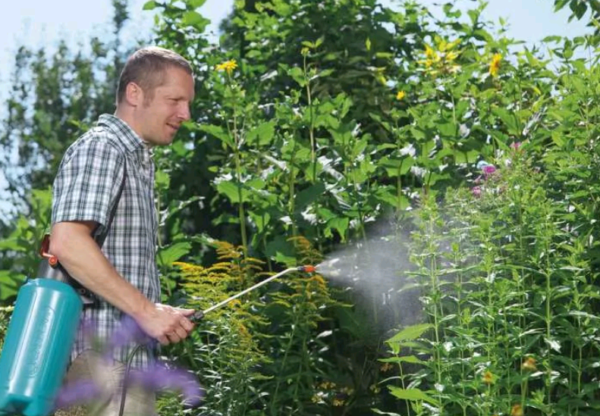
They fight parasites using different methods, and usually this is a complex of manipulations that in the end bring results. Timely and proper care is one of the points of this process: watering, feeding, spraying, loosening the soil, mulching.
Against aphids, miners and leafworms are used:
- Pyrimor 0.1%;
- Actellic 0.1%;
- Hostaquick 0.1%;
- Kronefos 0.3%;
- Fozalon 0.1-0.2%;
- Etophos 0.2%.

A mixture of bitoxybacillin 0.7% with pyrimor 0.03% gives a 95-100% victory over aphids and leafworms.
Spider mites are exterminated when there are two or three individuals on each leaf, using:
- Phosphamide 0.15-0.2%;
- Celtan 0.2%;
- Fozalon 0.1-0.2%;
- Metaphos or karbofos 0.2-0.3%;
- Acrex 0.2%.
Diseases and pests
An infection that can attack spirea is fungus or root rot.To avoid this, you should avoid stagnant water, regularly dig up and mulch the ground. With regards to parasites, the most dangerous for the shrub:
- aphids (the peak of infection is in the summer months, untimely treatment is fatal to the plant);
- spider mite (no less dangerous than aphids, and also leads to the death of a flowering bush; calmly survives the cold in the leaves);
- leaf rollers;
- miners.
To avoid the invasion of pests, you should carefully monitor every change in leaves, stems and flowers, and also regularly prune the plant, loosen and mulch the soil.
Plant pruning
Despite some misconception, pruning shrubs is important not only for giving the spirea the necessary shape, but also as a mandatory agrotechnical measure that allows you to rejuvenate the plant, act as a prevention of many diseases, and also help get rid of the invasion of pests. Each type of spirea has its own pruning features.
For summer flowering varieties, the following procedures are recommended:
- Stimulation of growth - pruning is carried out in early spring, during the period of leafing and is the shortening of all strong young shoots to places where powerful buds are located. Additionally, weak, deformed and damaged branches are removed from the bushes. From the age of 5, all branches are shortened by 25-30 cm annually.
- Formative pruning - Spirea tolerates pruning injuries well, and the recovery process occurs as soon as possible. That is why, the formation of a bush is allowed to be carried out several times a season.
- Rejuvenation is a procedure for removing old, damaged or deformed branches that do not form inflorescences. The optimal time for anti-aging pruning is the autumn period (1-2 weeks before the start of frost).

Spirea Vangutta - Spiraea vanhouttei
A hybrid of Cantonese spirea and three-lobed spirea (S. cantoniensis x S. trilobata).
Shrub height and diameter the crowns reach 2 m.The shape of the bush is spreading - the branches droop down in an arc-like manner,
forming a beautiful cascade shape.
The flowers are snow-white, in hemispherical inflorescences, densely cover the entire shoot along the entire length.
Flowering for about 3 weeks. In the suburbs, it falls at the end of May, beginning of June.
It is also beautiful with its foliage. In summer, the foliage is grayish, and in autumn it turns into bright purple-copper colors.
Spirea Wangutta grows quickly, light-requiring, tolerates light shading, unpretentious, drought-resistant, frost-hardy.
Very effective during flowering! Will fit well into any landscape.
Reproduction
Spirea is distinguished by a high ability to recover, which not only makes it possible to form bushes almost throughout the year, but also to propagate it as needed. Taking root quickly, this plant can multiply in any way, but cuttings and layering are considered the most effective methods.

By cuttings
The most simple to implement is the method of grafting. The best time for such a procedure is considered to be the beginning - mid-autumn (from September to the end of October). Lignified cuttings, which are cut during this period, have time to take root well before the onset of winter, after which they will have a state of dormancy, which will allow active growth with the onset of spring.
There is a possibility of planting cuttings in the middle of summer, but this method requires a more careful approach (for example, the cuttings themselves should be harvested in March and then prepared before planting in open ground in room conditions, with regular spraying and watering), and therefore practically never applies.

The propagation process by cuttings consists of several stages:
- planting material is obtained using a vertically growing one-year shoot, which is cut into cuttings (at least four leaves should remain on each of them);
- in a prepared container, the cuttings are planted 2 cm deep at an angle of 45 °.
Important! The angle of inclination must be observed without fail, since this position of the plant will also stimulate the growth of new roots. After the rooting process of the cuttings is completed, the container with them is covered with film or glass and placed in a shaded place.
The main thing here is not to overdo it - a little heat and sunlight will not interfere with the shoots, and therefore the northern side of the site will not work. Before the onset of the first cold snaps, the cuttings should be sprayed with a spray bottle several times a week. This approach will ensure that the humidity level is kept at the required level (at least 85%)
After the rooting process of the cuttings is completed, the container with them is closed with a film or glass and placed in a shaded place. The main thing here is not to overdo it - a little heat and sunlight will not interfere with the shoots, and therefore the northern side of the site will not work. Before the onset of the first cold snaps, the cuttings should be sprayed with a spray bottle several times a week. This approach will ensure that the humidity level is kept at the required level (at least 85%). 
During the period when the air temperature drops to + 1 ... + 3 ° С, the container with spirea cuttings is added to the drop. For these purposes, a bed well sheltered from the winds will be the most suitable. It is here that the container is deepened into the soil, and the plants themselves are thrown with dry foliage, and from above they are covered with a wooden box.
With the onset of spring, the spirea will give the first shoots, and therefore it is recommended not to immediately transplant it to a permanent place, but to allow it to grow for some time in the heated soil of the garden.If the growing region is characterized by severe winters, the container with cuttings should be placed indoors for the winter ( for example, a cellar).
Video: How to propagate spirea by cuttings
Layers
The method of propagation of spirea by layering is another method of vegetative propagation. For these purposes, young shoots with flexible branches that will need to be bent to the ground are most suitable. The optimal time for this is the beginning of autumn.
The procedure itself consists of several stages:
- selected branches are pressed to the ground;
- firmly fixed in several places with staples or wire;
- covered with soil;
- watered abundantly (water should be at room temperature).

Depending on the method of pressing, the number of future shoots will depend. If the branch is pressed along its entire length, with the onset of spring, several new shoots can be observed at once. If the branch is fixed at only one point, the number of shoots will decrease to one, but the young plant will have a strong structure.
Varieties of Japanese spirea
"Anthony Waterer" is characterized by narrow-lanceolate dark green leaves with a spectacular purple color with the onset of autumn. Intense pink flowers appear in mid-summer.
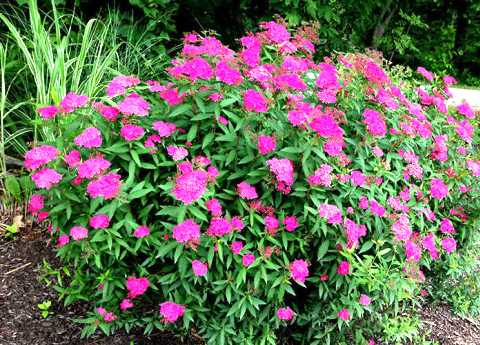
"Little Princess" is a compact rounded bush just over half a meter high. In late spring to mid-summer, it is covered with numerous pink inflorescences. The green leaves take on a gorgeous red hue in the fall.

"Macrophylla" is a large shrub about 1 meter high with large rounded leaves, which amaze with their decorative effect in the autumn, acquiring all shades of red, orange and purple.

Albiflora is a compact shrub, reaching about 60-80 cm in height, characterized by a white flowering.

Miniature round-shaped variety "Golden Carpet" only 20-30 cm tall with creeping shoots. Attracts gardeners with amazing lemon-colored foliage.

Spirea "Golden Princess" is a low compact bush that reaches 50 cm in height and 80 cm in width at the age of 10.Numerous small leaves of intense golden color retain their hue throughout the growing season. In summer, the ornamental value of the plant increases due to the abundant flowering.
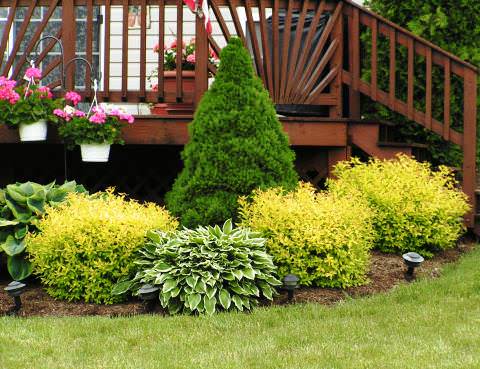
Variety "Dart's Red" about 60 cm high. Leaves are light green lanceolate, flat ruby-pink inflorescences adorn a round bush from June to September.
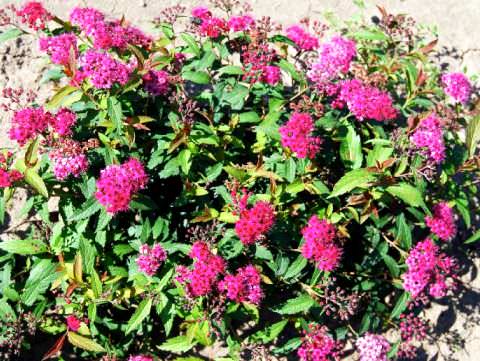
The variety "Japanese Dwarf" or "Japanese gnome" is a compact dwarf shrub, about 40 cm in height. The annual growth is 5 cm. During the flowering period, the bush is covered with large pale pink inflorescences.
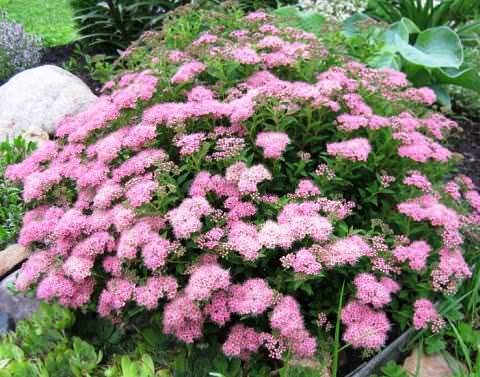
"Bullata" - the original variety, which is a low-growing bush with dark green wrinkled leaves. Its height is about 40 cm. Ideal for decorating rockeries and alpine slides.
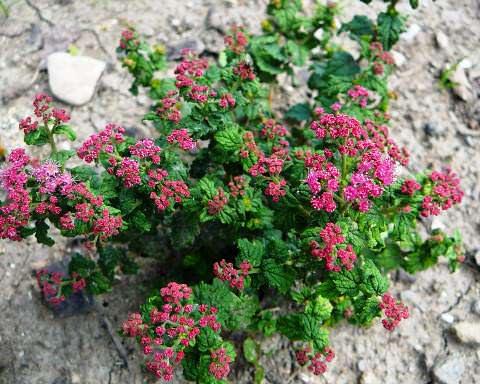
"Crispa" is a varietal form with serrated leaves and large pink inflorescences. It grows up to 60 cm. In autumn, the leaves turn reddish-purple.
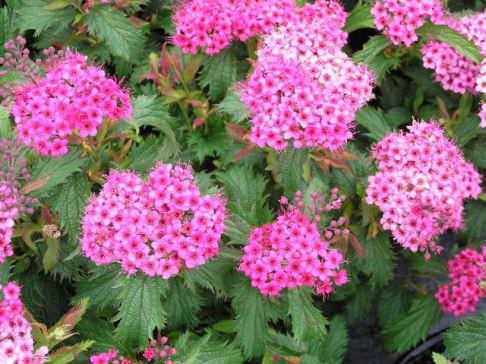
Walbuma, commonly sold under the trademark Magic Carpet, was bred by an English breeder and is a ground cover and expanding shrub with small, bright pink buds.
Its young creeping shoots and leaves are first orange-red in color, and as they grow, acquire a lemon color, which varies depending on the lighting. In full sunlight, mature leaves are golden, and in partial shade, golden green.
Autumn color of foliage - red-pink, plant height 30-40 cm.
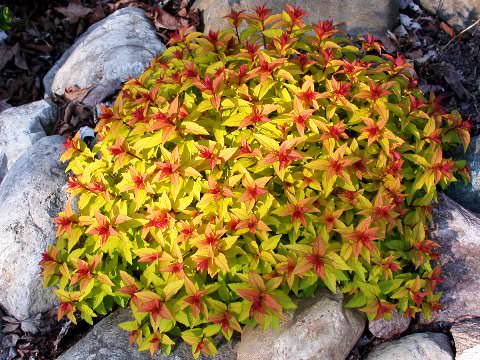
The variety "Goldflame" or "Golden Flame" got its name from the shoots, which seem to "burn" at the tips with an intense copper color - young leaves, first with a shade of brown and red, and in a later period turn yellow-green.
Therefore, in the spring, this variety of Japanese spirea is one of the brightest shrubs.
Dark pink flowers are formed on the shoots of the current year.
The height of an adult bush is about 80 cm.

Varietal form "Goldmound". A fabulous shrub with bright, sunny foliage, the color of which depends on the brightness of the light.
When planted in the shade, it loses its decorative color as the foliage turns green.
Easily withstands minus 30 degrees and even lower temperatures.
Bloom from May to July.
A beautifully rounded bush grows up to 60 cm in height.
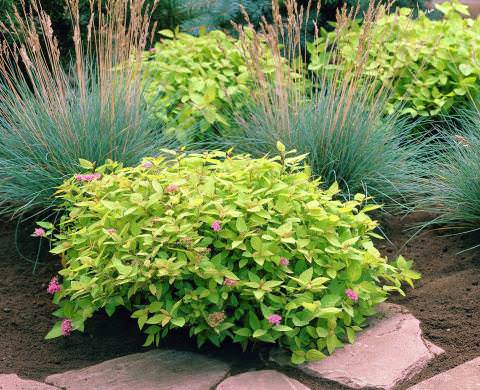
Plant diseases and pests
Spirea is a plant that has a stable immunity to many diseases. However, some diseases can still affect the bush, and therefore every gardener is obliged to know the first signs of diseases and how to treat them. This will help to save on the site not only the spirea itself, but also nearby plants.
Important! All infected parts of the bush should not only be removed from the plant, but also burned to prevent the spread of the disease throughout the area. Diseases:
Diseases:
- Brown spot is a fungus that looks like light green spots on the leaves. After a short time, such spots greatly increase their size, changing color to yellow or brown. On the back of the foliage, a gray bloom forms, which is a breeding ground for fungal spores. In the absence of correct and timely treatment, the leaves dry out and fall off, and the bush itself begins to lag behind in growth and development. You can get rid of brown spot by removing all affected plant fragments, with additional spraying with copper sulfate (3% solution). Popular methods are also widespread. For example, using a garlic-based solution, which, with a small lesion, may well replace chemical treatment. To prepare it, 500 g of finely chopped garlic is added to a bucket of water and infused for several days.
- Gray rot is a fungal disease that at the initial stage looks like red-brown spots that cover the entire surface of the plant, both branches and foliage.The development of the disease proceeds at a very high speed - the area of the spots increases, and the lesions themselves are covered with mycelium and spores, which are of particular danger. The wind is able to spread these small particles throughout the entire area, infecting all plants in the vicinity. The optimal condition for the development of gray rot is prolonged high humidity. For the treatment of the disease, treatment with fungicidal preparations (for example, "Topaz") is used. Also, there are folk recipes, such as, for example, an ash solution, which should be applied along with watering at the root. To prepare it, you need 0.4 kg of ash, which dissolves in a bucket of water.
There are cases of invasion of various pests on the spirea, among which it is especially common:
- Aphids are small insects that are dangerous because of their large numbers. They feed on the juice of foliage and shoots. To get rid of aphids, treatment with pesticide preparations or infusions made according to folk recipes, for example, infusion with tobacco or soap, is used.
- A spider mite is an insect that, feeding on the sap of a plant, leads to its complete drying out, or to a significant slowdown in growth and development. As a control, insecticide treatment is used. Do not forget about preventive measures - regular and timely pruning.
- Leafworms are caterpillars of butterflies that feed on the leaves of the plant, which can completely destroy the green mass of the bush. In addition, these pests hide in the leaves, simultaneously twisting and entangling them with cobwebs. With a small amount, you can get rid of the leafworm by removing the affected foliage, or mechanically (p.
Planting Japanese spirea
The plant can be planted in spring or autumn in cloudy or rainy weather. First, you should inspect the roots of the seedling, remove the weak and damaged and shorten too long
The vegetative part of the bush is also shortened by about a third of the length, this is especially important for plants with overdried roots. It is recommended to dip them in water for a while before planting.
Spirea is unpretentious and can develop well on ordinary sod land. You can prepare a special composition for planting, which is a mixture of earth, peat and sand in the ratio: 2: 1: 1. The plant feels good in the neighborhood with juniper, thuja, prefers sunny places, as you can see in the photo.
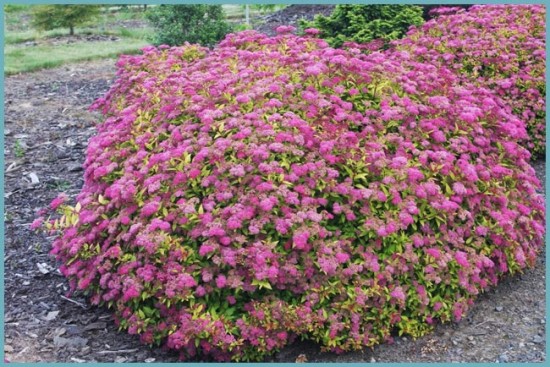 Japanese spirea responds very well to mulching
Japanese spirea responds very well to mulching
Sequence of operations when landing:
- Prepare a hole, the volume of which is about 3 times the root system of the seedling.
- Lay a layer of sand or broken bricks at the bottom of the pit for drainage to prevent stagnation of water that harms the roots.
- Place the plant in the hole, while placing the root collar of the seedling on the same plane with the soil surface.
- Gently fill the remaining space with the prepared mixture, lay the mulch on top with a layer 7 cm high, you can use peat, sawdust or compost for this purpose.
- Water the plant thoroughly.


